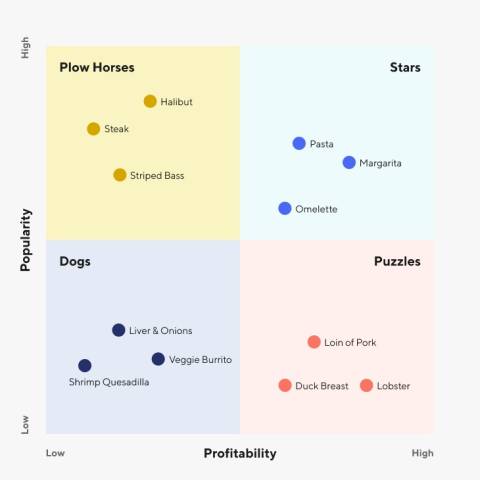Running a restaurant is a balancing act. To stay in business, operators are constantly monitoring their restaurant costs and looking for ways to run their operations more efficiently — all while staying on top of inflation-driven price increases that have become a way of life today.
With a little bit of planning and discipline, you can improve profits by keeping a close eye on your restaurant costs and brainstorming creative strategies to keep them as low as possible.
Breakdown of restaurant costs
Restaurant operating costs are those incurred in the process of running a restaurant — and can be categorized as fixed, variable, or semi-variable.
Fixed costs are consistent every month, such as rent or insurance.
Variable costs change according to circumstances, which makes them less predictable. Your ingredients are a good example of variable costs.
Semi-variable costs are a hybrid of fixed and variable costs. Labor is considered a semi-variable cost if you have both salaried employees (fixed cost) and hourly employees (variable cost).
Adding up the fixed costs, variable costs, and semi-variable costs will give you your restaurant’s total operating costs. While every restaurant is unique, most restaurateurs’ greatest cost categories are:
Cost of goods sold (COGS): The total cost of all ingredients needed to create your menu items.
Operations: The indirect costs of running your restaurant, including rent/mortgage, kitchen equipment, utilities, technology systems, insurance, property taxes, packaging, marketing and advertising, repairs and maintenance, and more.
Labor: The total cost of employing your team, including salaries and wages, benefits, and payroll taxes.
Operators can track these costs and their revenues in a Profit and Loss (P&L) statement to determine profits.
9 tips for reducing restaurant costs to get higher profits
1. Negotiate with suppliers
Operators can partner with their suppliers to try different strategies for improved pricing, such as bulk ordering or prepaying for items.
At the recent DoorDash Main Street Summit in Los Angeles, Kwini Reed of Poppy + Rose shared her cost-saving mindset when it comes to vendor partnerships:

We're constantly looking at our revenue and expenses. I'm in the books and scrubbing. ‘Do I need this? Can I get a better rate here?’ If you have three different purveyors, you need to start bargaining and figure out how to get costs down.
You can also experiment with new packaging and shipping methods to reduce costs and streamline operations for your vendors. Briana Valdez, Founder & CEO of Los Angeles-based TexMex restaurant HomeState came up with several efficiencies to overcome inflation challenges with her suppliers. First, she asked vendors to repackage her butter shipments into five pound blocks instead of traditional sticks. She also reduces restaurant costs by having her supplier blend eggs in advance instead of shipping them in-shell. This method also saves time for her own team, who no longer has to crack thousands of eggs each day.
Briana also spoke at the Main Street Summit in Los Angeles, sharing tips on how to build strong relationships with vendors. You can watch the full session on YouTube.

You can't just say to your vendor, 'Hey I need to get my prices down.' It definitely has to be a partnership, so think about what solutions you can bring to them.
Finally, you can try to find lower-cost suppliers to lower your food cost percentage. While restaurant suppliers appreciate loyalty, it might make sense to ask around your network and find options for new suppliers if you feel you're being charged too much for raw materials. Perhaps you'll be able to purchase the same quality ingredients at a lower cost.
2. Buy seasonal ingredients
You can please your customers and save money by buying ingredients in season — when they’re plentiful, and at the right price.
An in-season menu also means you're offering guests the freshest ingredients that taste best right at this moment. Tomatoes and corn in the summer, pumpkin in the fall, cranberries in winter — offering these bold flavors on your menu will get customers excited to dine at your restaurant. Guests will also appreciate that you're supporting local farms, so be sure to highlight where your ingredients come from on your menu.
A seasonal menu also creates ongoing opportunities to launch a limited time offer (LTO) featuring a seasonal special to drive sales. Limited availability of an item creates urgency for the consumer, who believes that they need to act soon or miss out on the experience.
3. Conduct a menu engineering analysis
Restaurant owners can increase profit margins through menu engineering — a strategy to analyze the profitability and popularity of individual menu items. Start by breaking down costs for your dishes, including all ingredients, to determine the exact cost of each menu item (not including labor). Then, use this information to categorize your menu items by sales volume, profit, and popularity levels during a specific time period. Conducting this analysis will help you understand which items are most and least profitable.

DoorDash partners can easily view which menu items are most popular by building a report in the Merchant Portal.
To reduce restaurant costs, review your least profitable dishes and brainstorm ways to make them more profitable. Can you substitute in lower-cost ingredients? Can you launch a promotion to drive sales? Can you write a more compelling menu description? If they're not profitable or popular, consider removing them from your menu entirely.
By finding ways to maximize profitable dishes and improve underperforming items, restaurant operators can determine the optimal pricing strategy and menu design for their business.
4. Embrace plant-based dishes
The price of staple proteins like beef, poultry, and pork has steadily increased in recent years thanks to inflation, supply chain issues, and a drought impacting much of the US agriculture industry. As a result, meat prices were 7.5% higher in August 2022 than the prior year.
Restaurants looking to reduce costs and cater to consumer preferences can supplement or substitute meat items with lower-cost plant-based ingredients. Research group Lumina Intelligence found that only 20% of all dishes served at restaurant chains in summer 2022 contained meat — a 4% decrease from spring 2022.
Consider high-protein meat alternatives such as beans, quinoa, lentils, chickpeas, and tofu — which work great in veggie burgers, salads, grain bowls, and tacos. Briana Valdez from HomeState introduced vegan menu items, such as their new black bean taco and oat milk-based beverages, to reduce the cost of the dishes and also appeal to diners focused on healthy living and sustainable food practices.

We just changed our cookie milk to be oat milk-based, then shared it on Instagram. It got people interested in ordering a lower-cost beverage and also got people excited because our menu doesn't change that often.
5. Minimize food waste
With CoGS being such a significant portion of your restaurant’s overall costs, it pays off to throw away as little food and ingredients as possible. Not only is excessive food waste notoriously bad for the environment, but it can also negatively impact your restaurant profit margin.
To minimize what you're throwing away at the end of every day, conduct a thorough waste analysis. Track the weights and types of waste (paper goods, produce, meat, etc.) to get a baseline understanding. Next, ensure your staff is storing food properly and your prep cooks are yielding the most out of your ingredients. For example, rather than toss what you don’t use, you can make soups and broths with many of your food prep leftovers.
Smart inventory management also helps to minimize waste. Monitor your sales data to forecast busy and slow days so you can order the correct amount of ingredients. Are your customers always taking home doggie bags, or leaving the table with food on their plate? Consider plating with smaller portions, or offering smaller sizes so customers can choose how much they want to eat.
6. Reduce employee turnover
Labor costs are another top expense for restaurants. But as every restaurateur knows, their employees are their greatest asset. That's why it makes good business sense to pay your employees as high a wage as you can.

We're making sure that we're keeping up and paying above minimum wage — not just the minimum, but above that, making sure that everything is fair.
You can also analyze your scheduling to avoid overstaffing during slow periods and reduce overtime costs. Cross-train employees to perform multiple tasks, which can provide flexibility in staffing levels. Consider using technology solutions such as automated ordering systems or self-order kiosks to streamline operations and reduce labor costs.
But one sure-fire strategy to reduce labor costs is to hold on to the employees you have, as it costs far more to replace an employee than it does to keep one. Here are two strategies to consider:
Promote from within: When hiring managers, look around at existing employees who may be ready for a leadership role. Because they already understand your operations and culture, it's often faster and more effective than waiting for the perfect external candidate. Give high-potential employees a clear path to career growth through internal training and development programs that help them rise up the ladder.
Offer a retention bonus: The cost of hiring a new employee is a lot higher than the cost of keeping your current one. HomeState began offering a $500 bonus to employees who stay for three months. While it may sound like a lot, it's helped to not only keep employees, but motivate them to recruit their friends and family.
"It's bred a lot of loyalty and has encouraged our team members to go out and tell their friends what they love about working here — which is a very authentic approach to recruiting," explains Briana. "People like working with their friends, and it's helped to breed a nice culture."
In a lively discussion from the DoorDash Main Street Summit Los Angeles, Othon Nolasco (Co-Founder, No Us Without You LA), Kwini Reed (Co-Owner Poppy + Rose, Poppy + Seed), and Akira Akuto (Co-Founder, Konbi) shared how they offer employee benefits to retain restaurant workers while still keeping restaurant costs down. You can watch the full session on YouTube.
8. Care for your restaurant equipment
Restaurant equipment includes appliances and tools for food prep, cooking, refrigeration, and storage. Whether you buy or lease equipment, outfitting a commercial kitchen can cost well over $100,000. With such a big investment, it's important to take care of these big-ticket items to ensure they always operate at peak performance.
A broken freezer costs more than the cost of replacing the freezer itself — it also includes labor and repair costs, the cost of spoiled ingredients, and revenue lost if you're forced to shut down the restaurant temporarily.
Scheduling regular cleaning and maintenance helps prevent breakdowns and extends the lifetime of the equipment. Train your team to get into the habit of thoroughly wiping griddles, burners, and grills; making sure fans are working; cleaning or replacing filters in the dishwasher and exhaust hood; inspecting fridge door hinges; and keeping an eye out for leaks in the storage and sink areas. Operators can also seek out Energy Star®-certified equipment to cut down on energy consumption and utilities costs.
9. Identify savings in your technology partnerships
Listing your business on apps like DoorDash can help you reach more customers and drive incremental sales, but make sure you're making the most of these technology partnerships. Here are a few ways to increase profits and get the most bang for your buck out of your DoorDash partnership:
Offer alcohol delivery: Add alcohol to your DoorDash menu which helps to increase ticket sizes and improve profitability, while maintaining compliance with local regulations.
Optimize your DoorDash menu: Follow our tips to maximize your menu to provide your customers with a better experience, ease the burden on your kitchen, and drive customer loyalty and growth.
Become a DashPass restaurant: Join DashPass, included in the Plus and Premier plans, to access DoorDash customers who typically order more frequently and spend more per order.
Set up Online Ordering: Build your brand and acquire new regulars with commission-free online ordering done directly through your own channels. Online Ordering integrates with your existing partners and offers personalized loyalty and gift card programs. Other companies charge monthly fees for this service, but with Online Ordering, you only pay for payment processing (2.9% + $0.30 per order).
Launch Sponsored Listings: Boost your store's visibility with ads in the DoorDash app and website. You’ll only be charged for orders placed through your ad — not for clicks or impressions.
Monitor restaurant costs to maximize profits
As operators know, running a restaurant successfully means keeping a close eye on operating expenses, brainstorming ways to reduce restaurant costs, and finding new ways to generate revenue.
For more restaurant money management tips, read our blog post on how to improve your restaurant profit margin, and download our free business budget template to help you track revenue and expenses.
And if you're looking for a way to build a bit more wiggle room into your restaurant budget, learn more about partnering with DoorDash — and how delivery and pickup orders can bring in incremental revenue for your restaurant.





